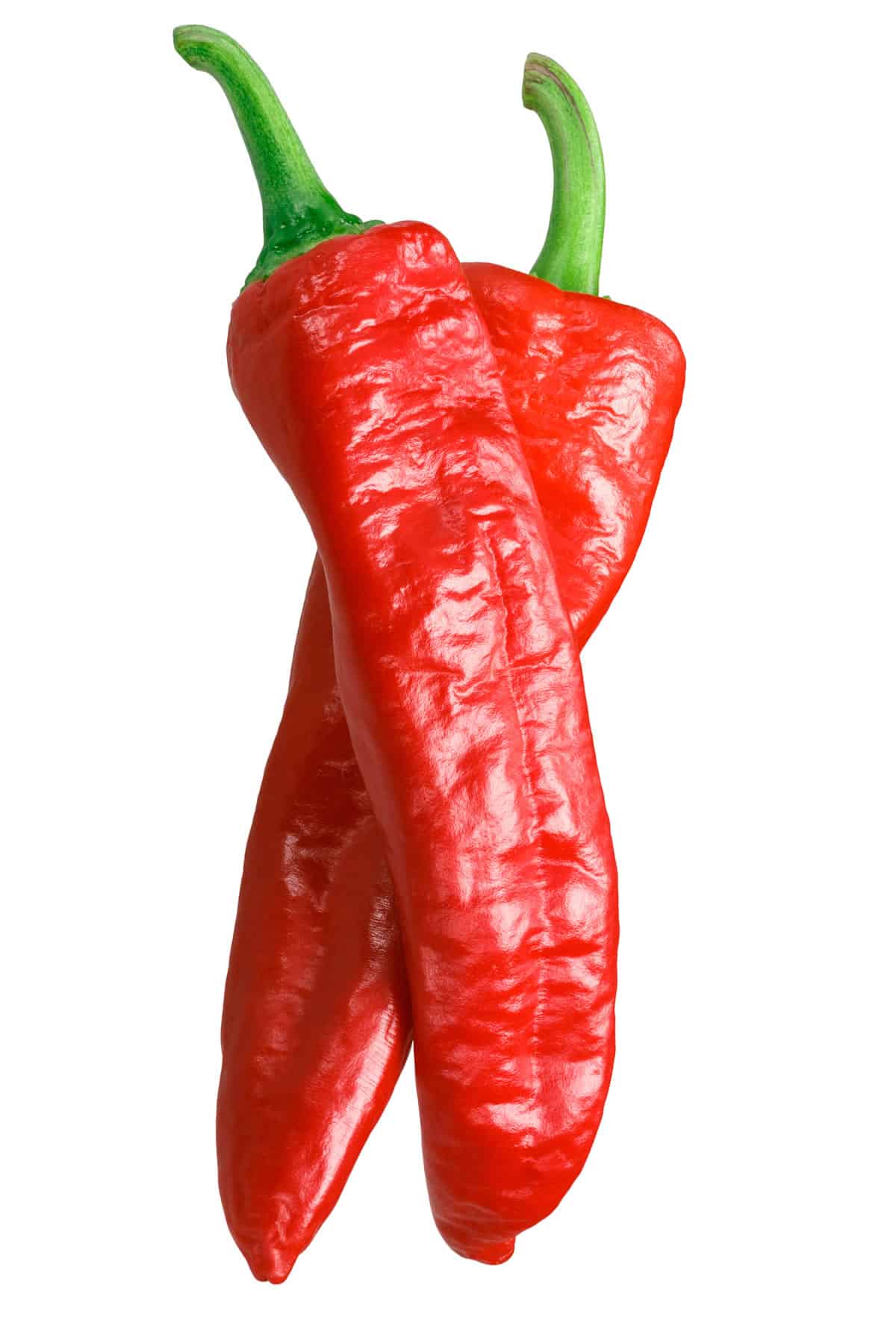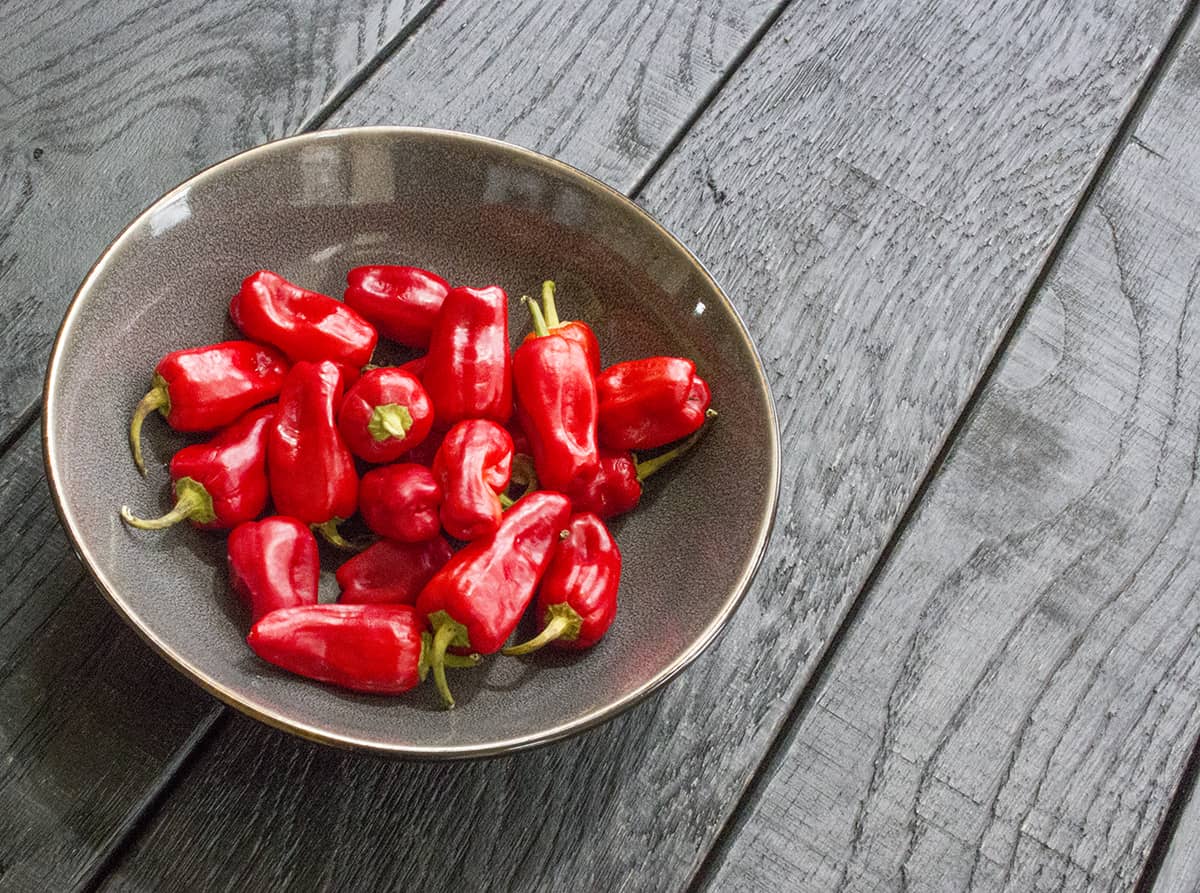The Aleppo pepper, also known as the Halaby pepper, is named after the Syrian city of Aleppo. It is commonly used as chili flakes in Mediterranean cuisine. Big flavor.

SCOVILLE HEAT UNITS: About 10,000 SHU
Capsicum Annuum
About the Aleppo Pepper
The Aleppo Pepper bears the name of its place of origin - Aleppo, Syria. Aleppo pepper is used in Mediterranean and Middle Eastern cuisine, although it has become very popular around the world as an alternative to crushed red pepper flakes or paprika, due to its beautiful deep red color, rich fruity undertones and aromatic flavor.
There is hardly any Mediterranean cuisine that doesn't benefit from the spicy Aleppo pepper, along with its wonderful fragrance.
The Aleppo pepper is also called the Halaby Pepper. When growing, the pods ripen to a vibrant burgundy color.
It is a member of the Solanaceae or nightshade family. After they mature, the pods are plucked by its farmers where they are typically semi-dried before being de-seeded and coarsely ground or crushed. Aleppo peppers are rarely used before they are turned into powder or flakes.
In Turkey, these pepper flakes are also called “pul biber”, and in Armenia, they are called “haleb biber”.
History of Aleppo Pepper
Though it may have originated from Syria, it is used widely in the United States and other parts of the world. With the violence and strife in Syria, obtaining Aleppo pepper is becoming more and more difficult.
Though it is now a common condiment, Aleppo pepper wasn't used outside the borders of Syria, Armenia, as well as Turkey, until the end of the twentieth century.
What does it look like?
The Aleppo pepper is similar in size and shape of a jalapeño, growing two to three inches long, with a long, curved appearance, with a tip that is more narrow than a jalapeno.
As the peppers age, they mature to a deep red color. You will more likely encounter the pods dried and ground into flakes in markets, however. They are more rarely found fresh.
I have grown these pods in my own home garden and the plants were quite productive. Here is a shot of some fresh pods picked directly from my garden. You’ll notice the vibrant red color.

What does crushed Aleppo pepper taste like?
Crushed Aleppo offers moderate heat level and great flavor, with a fruitiness offering hints of sun dried tomato, with a welcomed earthiness and slight tang. You’ll also notice a touch of salt is that it is used in the traditional method of drying Aleppo pepper.
The Aleppo flavor is reminiscent of the ancho chili, though a bit saltier and oilier, with a fruity raisin-like flavor.
How Hot is the Aleppo Pepper?
Conventionally, the Aleppo pepper is about half as hot as your typical chili flakes, offering a moderate level of heat. It measures in at 10,000 Scoville Heat Units on the Scoville Scale. Compared to a typical jalapeno pepper which averages 5,000 Scoville Heat Units (SHU), that makes it about twice as hot as a jalapeno.
Cooking with Aleppo Pepper
Aleppo pepper is used mostly in crushed pepper flakes form, is slightly oily and offers a mild heat level that slowly builds. With its inherent saltiness and somewhat raisin-like flavor profile, it is used in a big variety of recipes. It is different from other ground red pepper; it doesn't possess seeds or inner flesh.
The ground Aleppo pepper is a great substitute to ground paprika or red pepper.
Imagine using the Aleppo pepper in your delicacies; there is a great chance that you will swear off using ground red pepper. Its taste profile is out of this world and will leave you begging for more.
It is perfect for chili, pizza, sauces, pasta, any grilled meats (think kebabs) or roasted chicken, or anywhere you may normally use paprika, if you like the extra heat. However, it is not as hot as conventional crushed red chili pepper, because it is de-seeded and hotter innards removed before it is crushed.
Aleppo is also great as a colorful and tasty topping for potatoes, chicken, and even deviled eggs.
It is essential in dishes like muhammara, a roasted red pepper dip, or menemen, Turkish style scrambled eggs with peppers.
What’s a Good Substitute for Aleppo Pepper?
Use a combination of smoked paprika or sweet paprika with a pinch of cayenne pepper in place of Aleppo chili flakes. Cayenne is quite a bit hotter, but you'll find a good balance. A mix of ancho pepper and cayenne will work as well.
Looking to Buy Aleppo Pepper? Find Aleppo Pepper Products here (affiliate link, my friends).
You can sometimes find Aleppo red chile flakes in grocery stores, though you may need to order it online. Or, grow them yourself and grind them into a powder with a food processor or food mill. Learn more about dehydrating peppers, or dehydrating peppers to make chili powders.
NOTE: This post was updated on 1/18/22 to include new information. It was originally published on 5/10/15.
Learn About These Other Medium Chili Peppers
- Purple Jalapeño Peppers
- Chimayo Chili Peppers
- Paprika Kalocsa
- Piment De Bresse Pepper
- Cowhorn Chili Peppers: Good Heat, Big Pepper
- Aji Sivri Chili Pepper
- Jaloro Chili Peppers - All About Them
- NuMex CaJohns Serrano - One HUGE Serrano
- Cherry Peppers: All About Them
- Chilhuacle Amarillo Chili Peppers
- Cascabella Peppers: All About Them
- Sandia Chili Peppers
- Hungarian Wax Peppers - All About Them
- Aji Fantasy Chili Pepper
- Puya Chili Peppers (Chile Puya)
- Aji Habanero Chili Peppers
- Morita Chili Peppers
- Fresno Pepper - Much Like a Jalapeno
- There are even more here!


Mary says
Hi Mike, we have Aleppo peppers and I have been dehydrating them. My question is do the seeds need to be removed before grinding them into powder? The last ones I made I just crushed and left the seeds and used them like red pepper flakes.
Mike Hultquist says
Hi, Mary! You don't have to remove them, but some people find them bitter when they are processed. They also discover the final powder with flecks. Seeds are edible, though, but most people remove them when making powders. Enjoy!
Perry Kazulak says
I have been growing Aleppo peppers for 5 years here in Western New York. This was the first year my peppers did not turn red. I have dug them out of the ground repotted and brought in the house. Will they turn red? If not are they still as flavorful if they stay green. I would think not, thanks for your replies, Perry
Mike Hultquist says
I had some peppers that took forever to ripen this year as well. I would put them outside when the temperature allows, then bring them in when it gets cold. Yes, they should eventually ripen if the plant remains healthy. Also, yes, you can use the green ones. They will have an unripened flavor, but still good for green sauces
Jimbob says
Time travel?
"This post was updated on 6/8/21 to include new information. It was originally published on 1/18/22."
Michael Hultquist - Chili Pepper Madness says
Oops! Yes, my mistake. Thanks for alerting me.
Gretchen says
I grew Aleppos last year and made a Louisiana style hot sauce with them (using your recipe, of course!). It was so good and I had lots of people ask me for more that I'm dedicating several plants just for that purpose this year. They have a such a unique flavor that requires little else to make a great hot sauce.
Michael Hultquist - Chili Pepper Madness says
Nice! I love it. Thanks, Gretchen.
Michael Miller says
Hi Mike - great information! I'm looking forward to growing Aleppos next year as a new addition to the pepper garden.
In the meantime, do you know a source for dried whole aleppo peppers? I really like to toast and grind my own powders!
Michael Hultquist - Chili Pepper Madness says
Hi, Michael! Sorry, I don't have a resource for Aleppos, but check my Resources page for some potential contacts. Good luck! Great peppers.
Pamela Young says
I have some Piment d'Espelette pepper. Does the Aleppo pepper taste similar and can I use them interchangeably?
Michael Hultquist - Chili Pepper Madness says
Pamela, yes, you can. There are subtle differences in flavor, but this would be a good substitute.
Elihela says
Where can seeds for growing Aleppo chili be bought?
Michael Hultquist - Chili Pepper Madness says
Elihela, check out my Chili Pepper Plants and Seeds Resources Page for places to start with. Good luck! https://www.chilipeppermadness.com/resources/
Elihela says
Thank you very much.
Bien Nguyen says
Hello,
I love growing different types of peppers and would like to try my hands at Aleppo pepper. Where should I go to acquire some seeds?
Michael Hultquist - Chili Pepper Madness says
Bien, check out my Chili Pepper Resources page for places to find seeds and plants: https://www.chilipeppermadness.com/resources/
Bien Nguyen says
Thank you much!
Home Is A Kitchen says
Hi there! I love the idea of growing peppers at home and utilizing them. What I was wondering though is whether or not there are any good uses for fresh Aleppo pepper rather than dried flakes? Can they be used like any other pepper or is there a reason why they are mostly just dried and ground into flakes?
Michael Hultquist - Chili Pepper Madness says
Thanks, and hello! Yes, you can use the fresh pods as you use any other pepper. I grew them and used them for my everyday cooking, in mirepoix, etc. They're super popular for drying and grinding into flakes because of the flavor and heat, so really as a seasoning, though they are used in other ways as well. So many countries grow their own specialty peppers for making seasonings.
Bill Finn says
I grew Aleppo peppers this year for the first time and will continue to grow them. Plants grew well and were 2 1/2 feet tall and bushy. A beautiful small pepper, I dried and ground them into flakes. The aroma is addicting as is the flavor. This spice will replace 95% of the uses I have for the standard red pepper flakes.
Michael Hultquist - Chili Pepper Madness says
Thanks, Bill. Agreed, these are some amazing, flavorful peppers.